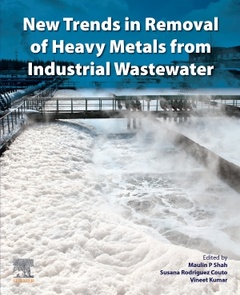New Trends in Removal of Heavy Metals from Industrial Wastewater
Coordonnateurs : Shah Maulin P., Rodriguez-Couto Susana, Kumar Vineet

New Trends in Removal of Heavy Metals from Industrial Wastewater covers the applicable technologies relating to the removal of heavy metals from wastewater and new and emerging trends in the field, both at the laboratory and industrial scale. Sections explore new environmentally friendly technologies, the principles of sustainable development, the main factors contributing to heavy metal removal from wastewater, methods and procedures, materials (especially low-cost materials originated from industrial and agricultural waste), management of wastewater containing heavy metals and wastewater valorization, recycling, environmental impact, and wastewater policies for post heavy metal removal.
This book is an advanced and updated vision of existing heavy metal removal technologies with their limitations and challenges and their potential application to remove heavy metals/environmental pollutants through advancements in bioremediation. Finally, sections also cover new trends and advances in environmental bioremediation with recent developments in this field by an application of chemical/biochemical and environmental biotechnology.
1. Introduction2. Types of heavy metals and their effect in wastewater3. Current physico-chemical treatment technologies available for remediation of different types of heavy metals from wastewater4. Biological wastewater treatment technology; advancement and drawbacks for the remediation of heavy metals5. Hurdles in wastewater treatment plants (WWTPs) performance optimization for the remediation of heavy metals6. Role of bacteria and algae in remediation of heavy metals from WWTPs7. Modified and new adsorbents for the removal of heavy metals from wastewater8. Removal of heavy metals using bentonite clay and inorganic coagulants9. Sustainable heavy metal remediation10. Efficient techniques for the removal of toxic heavy metals from wastewater 11. Full-Scale implementation of a vertical membrane bioreactor for remediation of heavy metals from wastewater12. Low-cost adsorbents, techniques and heavy metal removal efficiency13. Removal of heavy metals from mine waters by natural zeolites14. Functionalized magnetic nanoparticles for heavy metal removal from aqueous solutions: kinetics and equilibrium modelling15. Heavy metals in water: presence, removal and safety16. Mechanisms of heavy metal removal using microorganisms as biosorbents17. Heavy metal removal by bioaccumulation using genetically engineered microorganisms18. Genetic engineering of Escherichia coli for enhanced uptake and bioaccumulation of mercury19. New trends in removing heavy metals from industrial wastewater20. The construction of an engineered bacterium to remove cadmium from wastewater21. Genetic engineering of bacteria and their potential for heavy metal bioremediation22. Biosorption and bioaccumulation - the prospects for practical applications23. Batch and continuous removal of heavy metals from industrial effluents using microbial consortia
Dr. Maulin P. Shah is Chief Scientist and Head of the Industrial Waste Water Research Lab, Division of Applied and Environmental Microbiology Lab at Enviro Technology Ltd., Ankleshwar, Gujarat, India. His work focuses on the impact of industrial pollution on the microbial diversity of wastewater following cultivation-dependent and cultivation-independent analysis. His major work involves isolation, screening, identification, and genetically engineering high-impact microbes for the degradation of hazardous materials. His research interests include biological wastewater treatment, environmental microbiology, biodegradation, bioremediation, and phytoremediation of environmental pollutants from industrial wastewaters.
Susana Rodríguez-Couto (female) got her B.Sc. and M.Sc. in Chemistry (Industrial Chemistry) from the University of Santiago de Compostela in 1992 and her Ph.D. in Chemistry in 1999 from the University of Vigo, obtaining the maximal grade (magna cum laude) and, in addition, she was awarded with the Extraordinary Prize for Doctoral Thesis in Chemistry. She worked as an Associate Professor and an Isidro Parga Pondal Senior Researcher at the University of Vigo (2000-2004), as a Ramón y Cajal Senior Researcher at Rovira i Virgili University (2004-2008) and as an Ikerbasque Research Professor (2009-2019). She has also worked as an Invited Researcher at the Institute from Environmental Biotechnology, Graz University of Technology (Austria) and at the Department of Biological Engineering, University of Minho (Portugal). In 2008, she received the I3 Professor from the Spanish Ministry of Science and Education to the recognition of an outstanding research activity. In March 2021 she is joining LUT School of Engineering Science at Mikkeli, Finland, as a Full Professor in biological water treatment. She has published more than 140 articles in highly reputed international journals (h index 42). She is editor of several journals (3Biotech, Frontiers)
- Outlines the fate and occurrence of heavy metals in Wastewater Treatment Plants (WWTPs) and potential approaches for their removal
- Describes the techniques currently available for removing heavy metals from wastewater
- Discusses the emerging technologies in heavy metal removal
- Covers biological treatments to remove heavy metals
- Includes the valorization of heavy metal containing wastewater
Date de parution : 04-2021
Ouvrage de 748 p.
19x23.3 cm
Thèmes de New Trends in Removal of Heavy Metals from Industrial... :
Mots-clés :
Adsorbent; Adsorption; Advanced oxidation processes; Algae and bioreactor; Algae; Aqueous solution; Bacteria; Bioaccumulation; Biological process; Biological synthesis; Biological wastewater treatment systems; Bioremediation; Biosorbent; Biosorption; Biotransformation; Carbon sequestration; Chitosan; Coke-plant effluent; Conventional techniques; Cost; Cyanobacteria; Eco-friendly; Efficient technique; Emergent macrophytes; Environmental safety; Fungi; Granular sludge technology; Green synthesis; Green technology; Hazardous; Heavy metal adsorption; Heavy metal remediation; Heavy metal removal; Heavy metal toxicity; Heavy metal; Heavy metals; Higher availability; Humic substances; Industrial wastewater; Ion exchange; Iron nanoparticles; Kinetics; Low-cost adsorbent; Metal accumulation; Metalloids; Microalgae; Microbes; Microbial bioremediation; Microbial remediation; Microorganisms; Mining industry; Nanoadsorbents; Nanoadsorption; Nanobioremediation; Nanomaterials; Nanoparticles; Natural zeolites; Oxidizing bacteria; Phenol; Photocatalysis; Physicochemical treatments; Phytoremediation; Pollutants; Poly(vinyl alcohol)Polyphenols; Remediating mechanism; Remediation; Removal efficiency; Removal techniques; Resource and sustainability; Role of bacteria and algae; Sludge; Soil conditioner; Soil remediation; Sonolysis; Sonophotocatalysis; Sorbents; Sustainable development; Sustainable phytomanagement; Sustainable remediation; Tannery effluent; Toxic; Toxicity; Wastewater treatment plant; Wastewater; Water treatment; Wetland ecosystems; Xenobiotic; Zeolites



